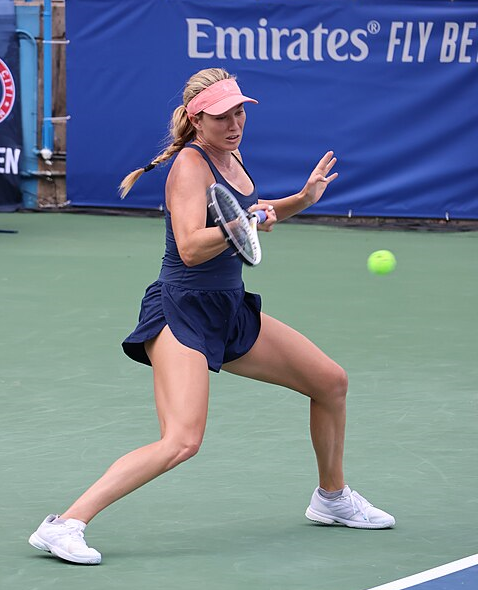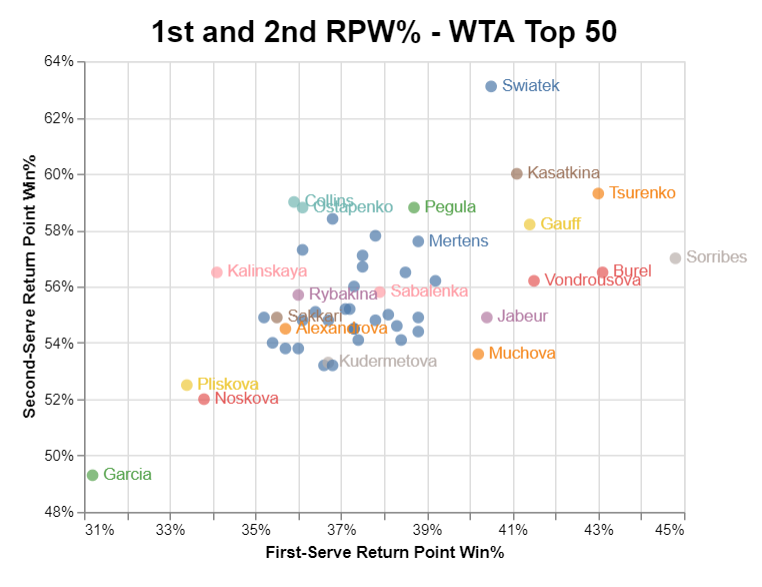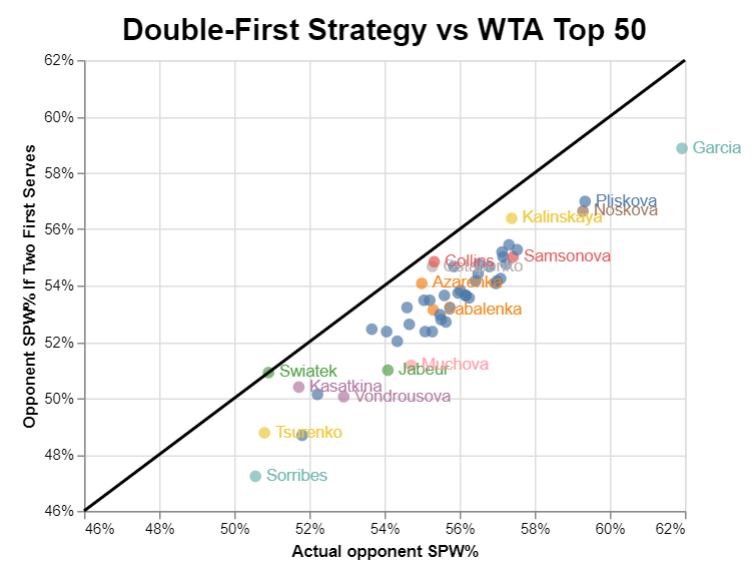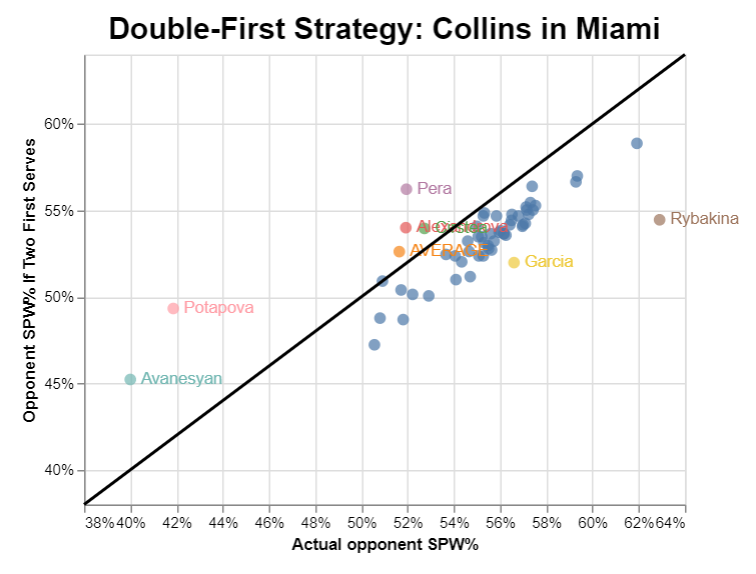
Yesterday in Charleston, Paula Badosa hit 21 second serves. She missed five of them, and it’s easy to see why. With Danielle Collins on the other side of the net, Badosa salvaged just six second-serve points, a 29% success rate. Go big with your second serve, and you’ll rack up double faults. Play it safe, and Collins will destroy you.
The American has never been kind to second serves, and her current hot streak is no exception. With the defeat of Badosa to open her Charleston campaign, Collins has won eight in a row, including upsets of Elena Rybakina and fellow giant-killer Ekaterina Alexandrova. Here are the second-serve return stats for her title run in Miami:
Round Opponent W% vs 2nd
Final Rybakina 45%
SF Alexandrova 67%
QF Garcia 50%
R16 Cirstea 62%
R32 Avanesyan 82%
R64 Potapova 86%
R128 Pera 71%
AVERAGE 64%
Defending champion Ons Jabeur, waiting in the Charleston second round, has every reason to be nervous. The last time she faced Collins, in Miami two years ago, the American snatched 69% of Jabeur’s second-serve points.
These numbers are outrageous. The average top-50 player on the WTA tour wins about 56% of second-serve return points. Over the last 52 weeks, Collins is one of only four women to post a mark of 59% or better. The others–Iga Swiatek, Daria Kasatkina, and Lesia Tsurenko–take a different approach, defending with consistency and strategy. No one among the legions of lower-percentage sluggers handles second serves better than Collins does. Jelena Ostapenko is close, winning 58.8% of second-serve return points, though against slightly weaker opposition. Rybakina and Aryna Sabalenka come in under 56%, and Alexandrova–perhaps the freest swinger of all–sits at 54.5%.
Badosa, then, has nothing to be ashamed of. On a typical day, Collins will maul your second serve. At her current level, you might as well be a ball machine set to easy.
Second to none
Collins’s second-serve return skill is rather specific. Many of the game’s best returners–Iga and Kasatkina, Coco Gauff, Jessica Pegula–are better than average against both first and second serves. They excel at handling a variety of serves, and they rack up points when they put balls in play and let rallies develop.
Danielle is different. She’s fourth-best among the top 50 in second-serve points won, but 41st when the same group is ranked by first-serve points won. Match Charting Project data tells us that she is among the worst on tour at putting first serves back in play. Her aggression against attackable first serves prevents her results from being too dire. But she struggles to get the point going when she can’t take a big swing.
Here’s a visualization of each player’s success rates against first and second serves. The relationship between the two is fairly close–much closer than equivalent results on serve–so the trend line from the lower left to upper right is evident. Women located toward the upper left corner, like Collins, are those who are better at returning seconds than firsts. Those toward the lower right, such as Karolina Muchova, are better (relative to average) at handling firsts than seconds.

The plot makes it clear how Collins stacks up against her peers. She cleans up second serves as well as otherwise superior returners, like Pegula and Gauff. Against first serves, she plays more like other big hitters, such as Alexandrova and Rybakina. On return, she is basically the same as Ostapenko, even if her overall approach isn’t as mind-bogglingly aggressive as the Latvian’s.
The first-draft game plan against Danielle, then, is to make some first serves. For the love of all that is holy, make some first serves.
Desperate measures
In Saturday’s Miami final, Rybakina did not do that. The fourth-ranked woman in the world owns what might be the best first serve in the game; the problem is that she doesn’t land many of them. When I wrote about her back in February, she was showing signs of greater consistency. Since then, however, she has reverted to her usual rate of making fewer than 60% of her first serves. Over six matches in Miami, Rybakina cracked 53 aces but found the service box only 58% of the time.
Against Collins, her first-serve rate fell to a measly 53%. That, more than anything else, determined the outcome of an awfully close match. The American earned seven break points, and Rybakina landed her first serve on just two of them. One or two more unreturned firsts at those critical moments, and the story of the final would have been quite different.
Given Collins’s assault on second serves, it is worth asking: Are opponents going about this the wrong way? If the American is relatively weak against harder serves, why not accept more double faults and hit two first serves against her?
Fans have speculated about a “double-first” strategy for years. Back in 2014, Carl Bialik examined its potential, and I followed up a year later. The general conclusion is that two first serves is not a good idea, though for a few women–Victoria Azarenka and Sara Errani among them, in Carl’s analysis at the time–it could have improved their results.
(I say could because we don’t know the knock-on effects of such a radical approach. Carl and I both assumed that if a player hit two first serves, all of their serves would continue to be as effective as before. That might not hold true if returners saw less variety coming from the other side of the net.)
In my follow-up, I found that many individual matches offered opportunities for a double-first attack. It was next to impossible to predict them ahead of time, so it still didn’t make for much of a strategy. But it left open the possibility that there was something to be exploited by skipping second serves altogether.
Collins almost presents such an opportunity. The following scatterplot shows each player in the WTA top 50 and how the double-first strategy would fare against them.

Returners to the right of the line–that is, everybody–are those who would do better against two first serves than against the status quo. Swiatek is an outlier here: Servers would fare almost exactly as well against her if they hit two first serves. Collins is next: Opponents would sacrifice only 0.5 percentage points of the serve win rate if they never hit a second serve.
In Miami, though, Collins’s second-serve return was even more fearsome than usual. Again, it would be difficult to predict specific matches when a double-first strategy pays off, but some of her opponents probably would have accepted more double faults if it meant watching fewer return winners come rocketing back. Here is the same graph, with bubbles added for each of Collins’s Miami matches and another for the average of her Miami opponents:

Sorana Cirstea is tucked in there behind Alexandrova; their service results against Collins were almost identical. Again, points to the left of the line indicate situations where the double-first strategy would have won more points than the way things actually went. It wouldn’t have been wise for Rybakina or Garcia, but Danielle’s other five opponents would have benefited.
The true solution to the Collins conundrum lies in between: some second serves, but more risk-taking all around. I outlined some of those tradeoffs when I wrote about Qinwen Zheng in January. Simply praying for more first serves doesn’t do the trick. With Danielle set to retire at the end of the season, the rest of the tour doesn’t have much time to figure it out.
* * *
Subscribe to the blog to receive each new post by email:
Carol G. needs to see the % 1st vs. 2nd serve return pts won chart
What happens when insisting on standing 4-ft inside the baseline to return